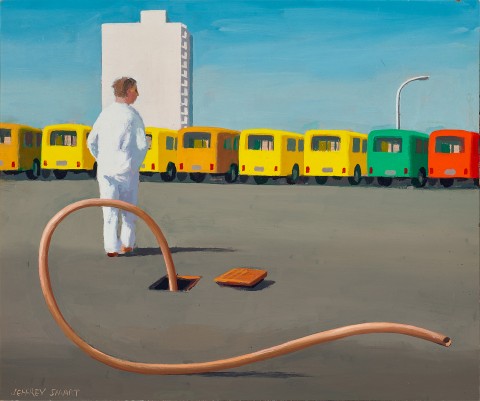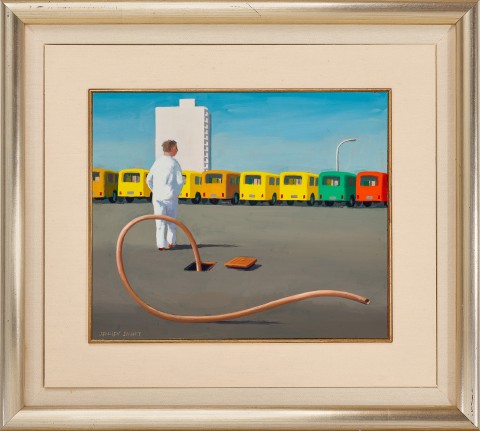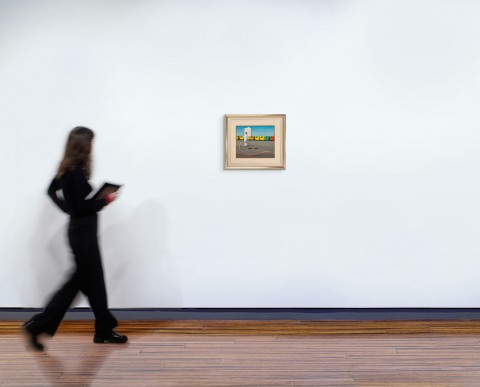Study for Bus depot, 1979
Jeffrey Smart
oil on prepared cardboard
26.0 x 31.0 cm
signed lower left: JEFFREY SMART
Australian Galleries, Melbourne (label attached verso, as 'Study For Bus By The Tiber')
Private collection, Melbourne, acquired from the above in 1981
Jeffrey Smart, Redfern Galleries, London, 7 June - 4 July 1979, cat. 31
Jeffrey Smart, Rudy Komon Gallery, Sydney, 8 November - 3 December 1980, cat. 41
Jeffrey Smart, Australian Galleries, Melbourne, 26 October - 7 November 1981, cat. 29
Quartermaine, P., Jeffrey Smart, Gryphon Books, Melbourne, cat. 741, p. 116
McDonald, J., Jeffrey Smart Paintings of the ’70’s and ’80’s, Craftsman House, Sydney, 1990, cat. 188, p. 159
We are grateful to Stephen Rogers, Archivist for the Estate of Jeffrey Smart, for his assistance with this catalogue entry.
Jeffrey Smart’s Study for Bus depot, 1979, with crisp lines and saturated colours, shines brightly. A lone worker, sporting white overalls that gleam in the sunlight, wanders through an empty bus depot; a hosepipe snaking from a central drain indicates his recently abandoned maintenance task. This jewel-like study, containing an anthology of the artist’s most powerful motifs, was painted during a high point of Smart’s career, joining contemporaneous masterpieces such as The guiding spheres (Homage to Cézanne), 1979 and Autobahn in the Black Forest I and II, 1979. Seven years after his emigration to Italy, in 1971 Smart settled in an old farmhouse in Posticcia Nuova, near Arezzo. The arrival of Ermes de Zan in this house in 1973 heralded what Smart would call ‘the beginning of the happiest time in my life’ and their comfortable cohabitation from 1976 corresponded with a golden period of creativity.1
The success of Smart’s pictorial intelligence lies in the combination of sharp observational and rigorous compositional construction based on classical geometry. In depicting the real-life building boom of post-war Italy, Smart’s paintings championed its uniform, anonymous imagery. An inveterate traveller and long-standing expatriate, Smart also displayed a predilection for depicting the mechanisms and modalities of contemporary transport. Fully enclosed, Smart’s bus depot is a space between destinations, an interstitial industrial area designed for vehicles and the workers he imagines servicing them. Here, a vast expanse of unmarked tarmac fills the frame, crowned by a row of candy-coloured parked buses and an apartment building which disrupts the horizon. The curlicue of the snaking tube provides surreal dynamism in an otherwise still composition.
Although appearing to be faithful recordings of real-world places, Jeffrey Smart’s paintings were most often composite images, constructed from disparate elements recalled from real-life locations or repurposed from other artworks. With a quality of completeness, this study is no mere aide-memoire and, in fact, represents the sole surviving record of one of his most successful compositions. The major work to which it related very closely, Bus depot, 1979, was tragically ruined during the framing process ahead of its exhibition in London’s Redfern Galleries in July 1979. This Bus depot was then cut down, retaining only the figure section on the left-hand side and truncating the hose motif to a closed arc. The figure lovingly painted, Bus depot effectively became a portrait of Ermes de Zan and was the only oil work of his own that Smart hung in their home at Posticcia Nuova.2
With its plastic pipe absurdly open-ended, dominating the foreground and guiding the viewer’s eye through the spiral of the Golden Mean, Study for Bus depot was the first of Smart’s paintings to use the motif of the cursive tube. The prosaic origins of the central motif were recalled by the artist in 1982: ‘Behind the house up on the hill there’s a spring and the pipes had become calcified... and we had to go and buy a whole lot of tubes at the hardware wholesale place near Arezzo... And I was just standing around and I saw this marvellous unwinding of pipe going on... I thought, ‘oh heavens what a lovely thing.’’3 A year later, when struggling with the composition of a portrait of his friend, the author David Malouf, Smart returned to the motif and the complete composition of Study for Bus depot, leading to the creation of what he declared to be ‘the best picture I have ever painted’ - Portrait of David Malouf, 1980 (Art Gallery of Western Australia).4
1. Smart, J., Not Quite Straight. A Memoir, William Heinemann Australia, Melbourne, 1996, p. 445
2. Communication with Stephen Rogers, Archivist for the Estate of Jeffrey Smart, October 2025
3. Jeffrey Smart, Interview for The Australian Eye series, 21 June 1982, transcript, National Library of Australia, oral trc 994
4. Jeffrey Smart, Letter to David Malouf, Fryer Folios (Brisbane), vol. 12, no. 1, cited in Jeffrey Smart, National Gallery of Australia, Canberra, 2021, p. 128
LUCIE REEVES-SMITH


